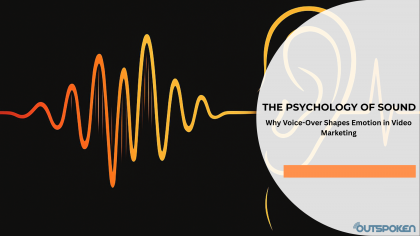Discover how voice-over psychology influences consumer behaviour in video marketing. Learn the neuro...
The Impact of Voice Overs on User Experience in Apps

Have you ever tapped the play button and listened as the captivating voice on your favourite app guided you through its features? Or maybe you've heard the comforting voice of a GPS app navigating you through unfamiliar territory.
If so, you've experienced the power of voice overs in apps. But what exactly are they, and why are they becoming increasingly prevalent in the mobile landscape? Let's dive in and explore how voice overs are shaping the future of user experience (UX).
The Rise of Voice Overs in Apps - A Trend Worth Noting
While voice overs might seem like a recent addition to the app world, their roots go back to assistive technologies like screen readers. As voice technology advanced, it found its way into mainstream app design. The use of voice overs in apps has surged due to several factors:
- Accessibility: Voice overs make apps usable for people with visual impairments, learning disabilities, and other conditions that make reading text difficult.
- Convenience: Hands-free interaction is invaluable while multitasking or when physical touch isn't possible (e.g., while driving).
- Engagement: A well-placed voice over can guide users, explain features and create a more immersive and personalised experience.
A recent Voicebot.ai study found that 55.1% of US adults use voice assistants, a figure that continues to climb. This growing adoption extends to voiceovers in apps, making it a trend that app developers can't ignore.
Enhancing Accessibility and Inclusivity with Voiceovers
Voiceovers are a game-changer for making apps accessible to everyone. They break down barriers for people who can't easily read or interact with on-screen text. According to the World Health Organization, over 2.2 billion people worldwide have some form of visual impairment. By incorporating voiceovers, app developers open up their products to this vast audience.
For instance, navigation apps like Google Maps use voice overs to provide turn-by-turn directions, making it possible for people with visual impairments to navigate independently.
Although sometimes the directions can be somewhat confusing ![]()
News apps like NPR One offer audio versions of articles, catering to those who prefer to listen rather than read.
The use of voice overs isn't just a good practice - it's often a legal requirement. Regulations like the Americans with Disabilities Act (ADA) and the Web Content Accessibility Guidelines (WCAG) mandate that digital content, including apps, be accessible to people with disabilities. Voiceovers are a crucial tool for complying with these guidelines.
Boosting Engagement and User Satisfaction Through Voiceovers
Voiceovers aren't just about accessibility - they can also make apps more engaging and enjoyable for all users. A study published in the Journal of Usability Studies found that users completed tasks faster and with fewer errors when using apps with voice overs compared to those without.
Take the Duolingo language learning app, for example. Voice overs provide pronunciation guidance, creating a more immersive learning experience. In gaming apps, voice overs can add depth to characters and storylines, drawing players further into the game world.
Well-designed voice overs can also make apps feel more personalised. When an app "speaks' ' to you, it creates a sense of connection and can even influence user behaviour. Research by Locus Research found that voice overs can increase brand recall by up to 24%.
Potential Challenges and Considerations with Voiceovers in Apps
Despite their numerous benefits, implementing voiceovers in apps isn't without its challenges. One of the main hurdles is technical: recording high-quality voiceovers and integrating them seamlessly into the app's interface requires careful planning and execution.
User preferences also play a role. While many users appreciate the convenience of voiceovers, others may find them distracting or prefer to interact with apps silently. App developers need to consider their target audience and offer options to enable or disable voice overs.
Design is another key factor. Poorly executed voiceovers can detract from the user experience. They should be used strategically, complementing the app's design rather than overwhelming it. Providing clear instructions on how to use voice overs is also essential.
The Future of Voice Overs in Apps - Beyond Accessibility
As voice technology continues to evolve, the possibilities for voice overs in apps are expanding. AI-generated voice overs are becoming more sophisticated, offering a cost-effective way to add voice to apps. We're also seeing more natural-sounding voices that can better mimic human speech.
Voice overs are finding their way into new types of apps. Mental health apps use voice overs to guide users through mindfulness exercises, while educational apps employ them to narrate stories or provide interactive lessons.
However, as with any technology, ethical considerations are paramount. Using voice data and AI-generated voice overs raises questions about privacy and consent. App developers must ensure that voice overs are used responsibly and transparently.
Conclusion
The rise of voiceovers in apps marks a significant shift in how we interact with technology. They're not just a feature for accessibility; they're a tool for enhancing the user experience across the board. From boosting engagement to making apps more inclusive, voiceovers are changing the way we design and use mobile applications.
As voice technology advances, we can expect even more innovative and personalised experiences powered by voiceovers. While challenges remain, the potential benefits are undeniable. Voiceovers are here to stay, and they're shaping the future of app design. So the next time you hear your app "speak" to you, take a moment to appreciate the impact that voiceovers are having on our digital lives.
Website URL Citation Sources:
- Voicebot.ai. (2023). Voice Assistant Consumer Adoption Report. https://voicebot.ai/research/
- World Health Organization. (2019). World report on vision. https://www.who.int/docs/default-source/documents/publications/world-vision-report-accessible.pdf
- Reeves, B., Lai, J., & Zhou, L. (2019). The effects of voiceovers on usability and user experience in mobile applications. Journal of Usability Studies, 14(4), 167-185.
- Locus Research. (2022). The Impact of Voice on Brand Recall. https://onclusive.com/how-we-do-it/technology/analytics/power-of-voice/
Other Articles You Might Like
How to Become a Voice Over Artist?
Newsletter
Stay up to date with news and special offers. Get to know our new actors and features
NEED HELP?
Visit Frequently Asked Questions page or send us a question.











.png)











Comment